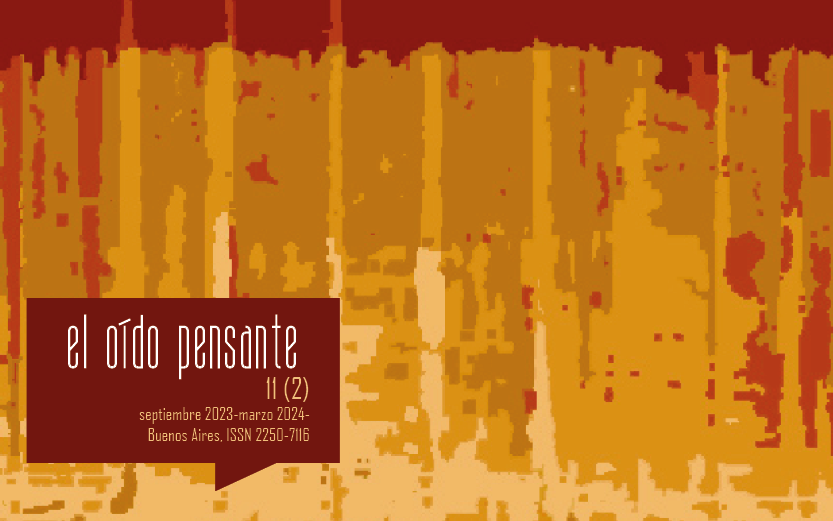Creatividad y construcción de nichos cognitivos en L’opera per flauto de Salvatore Sciarrino
Resumen
El surgimiento de nuevas ideas musicales y nuevas formas de musicalidad se describe en este trabajo como la transformación de espacios conceptuales en un nicho cognitivo, un conjunto distribuido y autoorganizado de conceptos, materiales y acciones intergeneracionales. De acuerdo con este enfoque, existe una relación codependiente directa, un looping causal coevolutivo, entre ideas musicales nuevas, aceptables (válidas) y sorprendentes (que definen lo que es creativo en un contexto determinado), agentes, herramientas y artefactos (instrumentos, notaciones musicales, tipos de equipamiento, espacio de actuación) y acciones epistémicas y pragmáticas concebibles (técnicas instrumentales, dinámicas colaborativas, procedimientos escénicos). Esta relación coevolutiva define un espacio conceptual de musicalidad. Para demostrar nuestra tesis, detallamos el desarrollo de técnicas extendidas para la flauta travesera, un fenómeno que depende en gran medida de la colaboración entre compositor e intérprete. Nos centramos en L’opera per flauto (1990), de Salvatore Sciarrino, que se desarrolló en un intenso trabajo con el flautista Roberto Fabbriciani, a través de la investigación de las posibilidades sonoras del instrumento. La colaboración dio como resultado sorprendentes nuevos sonidos para la flauta travesera, incluida la combinación de técnicas extendidas y su notación, ampliamente aplicada por el repertorio posterior.Descargas
Citas
Artaud, P.-Y. and Geay, G. (1980). Flûte au présent. Paris: Editions Jobert et Editions Musicales Transatlantiques.
Albertson, D. (2004). Foreword. Contemporary Music Review, 23(3/4), 3-5.
Angius, M. (2007). Come Avvicinare il Silenzo. La Musica di Salvatore Sciarrino. Roma: Rai Trade.
Atã, P. and Queiroz, J. (2016). Habit in Semiosis: Two Different Perspectives Based on Hierarchical Multi-level System Modelling and Niche Construction Theory. In D. West y M. Anderson (Eds.). Consensus on Peirce’s Concept of Habit: Before and Beyond Consciousness (pp. 109-119). Berlin: Springer.
Atã, P., and Queiroz, J. (2019). Semiosis is Cognitive Niche Construction. Semiotica, 228, 3-16.
Auner, J. (2013). Music in the Twentieth and Twenty-First Centuries. Western Music in Context: A Norton History. New York: W. W. Norton & Company.
Bardone, E. (2011). Seeking Chances: From Biased Rationality to Distributed Cognition. New York: Springer.
Bartolozzi, B. (1967). New Sounds for Woodwind. London: Oxford University Press.
Bickerton, D. (2009). Adam’s Tongue. New York: Hill and Wang.
Boden, M. A. (1999). Computer Models of Creativity. In R. Sternberg (Ed.). Handbook of Creativity (pp. 351-372) New York: Cambridge University Press.
Castello Branco, M. (2014). Das Instrument als Apparat. Analyse zeitgenössischer Musik für Querflöte auf der Grundlage der Medientheorie Vilém Flussers. (Ph.D. thesis). Universität der Künste Berlin, Berlin, Germany.
Cescon, Fa. (2002). Das atmende Klarsein di Luigi Nono: indagine analitica e filologica sulla prima esperienza di Luigi Nono con il live electronics. (Ph.D. thesis). Università Ca’ Foscari Venezia, Venezia, Italia.
Clark, A. (2008). Supersizing the Mind: Embodiment, Action, and Cognitive Extension. Oxford: Oxford University Press.
Dick, R. (1989). The Other Flute. New York: Multiple Breath Company.
Dick, R. (1986). Neuer Klang durch neue Technik. Frankfurt: Zimmermann.
Fabbriciani, R. (2007). Flauto in scena. (‘900 e oltre). In C. de Incontrera (Ed.). Quaderni di Cultura Contemporanea. Monfalcone: Teatro Comunale di Monfalcone.
Farwick, S. (2009). Studien zur zeitgenössischen Musik für Flöte Solo in der Zweiten Hälfte des 20. Jahrhunderts. New York: Peter Lang.
Geraci, T. (1995). Ein organischer Begriff des Klangs. Bemerkungen zu Salvatore Sciarrino. Wien Modern, 95(8), Wien: Pfau.
Griffiths, P. (2010). Modern Music and After. New York: Oxford University Press.
Gottschalk, J. (2016). Experimental Music Since 1970. New York: Bloomsbury Academic.
Habbestad, B. (2019). Working Together – An Interview with Roberto Fabbriciani. Music & Practice, 4. Retrieved from https://www.musicandpractice.org/volume-4/working-together-an-interview-with-roberto-fabbriciani/
Halfyard, J. (2016). Berio’s Sequenzas: Essays on Performance, Composition and Analysis. New York: Routledge.
Haselböck, L. (2019). Hörbare Stille? Sichtbarer Klang? Zur »Ökologie der Wahrnehmung« in Salvatore Sciarrinos Streichtrio Codex Purpureus (1983). In U. Tadday (Ed.). Musik-Konzepte. Sonderband Salvatore Sciarrino. München: Edition text+kritik.
Hoffmeyer, J. (2008). The Semiotic Niche. Journal of Mediterranean Ecology, 9, 5-30.
Honing, H. (2018). The Origins of Musicality. Cambridge: The MIT Press.
Hutchinson, G. E. (1957). Concluding Remarks. Cold Spring Harbor Symposion on Quantitative Biology, 22, 415-427.
Kirsh, D and Maglio, P. P. (1996). Epistemic Action Increases with Skill. In G. W. Cottrell (Ed.). Proceedings of the 18th Annual Conference of the Cognitive Science Society (pp. 391-396). New York: Routledge.
Koizumi, H. (1996). Technique for Contemporary Flute Music: for Players and Composers. Japan: Schott.
Laland, K., Odling-Smee, J. F. and Feldman, M. W. (2000). Niche Construction, Biological Evolution, and Cultural Change. Behavioral and Brain Sciences, 23(1), 131-175.
Laland, K., Blake, M. and Feldman, M. W. (2016). An Introduction to Niche Construction Theory. Evol Ecol, 30, 191-202.
Lanz, M. R. (2010). Silence: Exploring Salvatore Sciarrino’s style through L’opera per flauto. (Ph.D. thesis). University of Nevada, Las Vegas, USA.
Levine, C. and Mitropoulos-Bott, C. (2002). Die Spieltechnik der Flöte. Kassel: Bärenreiter.
Lewontin, R. (1983). The Organism as the Subject and Object of Evolution. Scientia, 77(188), 65-82.
Lewontin, R. and Levins, R. (1997). Organism and Environment. Capitalism Nature Socialism, 8(2), 95-98.
Lozzi, B. and Mencarelli, P. (1975). Metodo per flauto. Milano: Edizioni Suvini Zerboni.
Magnani, L. (2007). Creating Chances through Cognitive Niche Construction. In B. Apolloni (Ed.). Knowledge-based Intelligent Information and Engineering Systems (pp. 917-925). Berlin: Springer-Verlag.
Magnani, L. (2009). Abductive Cognition: The Epistemological and Eco-cognitive Dimensions of Hypothetical Reasoning. Berlin: Springer.
Messiaen, O. (1980). Introduction. In P. Artaud and G. Geay (Eds.). Flûte au présent. Paris: Editions Jobert et Editions Musicales Transatlantiques.
Nyffeler, M. (2008). Der Klang aus der Stille der Nacht. Salvatore Sciarrino, die Sprachkraft der Musik und die Kunst des Hörens. Retrieved from http://www.salzburgerfestspiele.at/downloads/nyffeler_de.pdf
Odling-Smee, F. J., Laland, K. and Feldman, M. (2003). Niche Construction: The Neglected Process in Evolution. Princeton: Princeton University Press.
Peirce, C. S. (1931–1935). The Collected Papers of C.S. Peirce, vols. I-VI, edited by Charles Hartshorne and Paul Weiss, Cambridge: Harvard University Press; 1958, vols. VII-VIII, edited by Arthur. W. Burks, Charlottesville: Intelex Corporation. (Quoted as CP, followed by volume and paragraph).
Peterson, A. T., Soberón, J., Pearson, R. G., Anderson, R. P., Martínez-Meyer, E., Nakamura, M., Araújo, M. B. (2011). Ecological Niches and Geographic Distributions. Princeton: Princeton University Press.
Rehfeldt, P. (1994). New Directions for Clarinet. Oxford: University of California Press.
Sciarrino, S. (1990). L’opera per flauto. Milan: BMG Ricordi Music Publishing.
Sciarrino, S. (1995). Fabbrica degli Incantesimi - L’opera per flauto. Col Legno. Compact disc.
Sciarrino, S.. (2008). Frammento e Adagio. Kairós. Compact disc.
Sciarrino, S.and Furrer, B. (2010). Donaueschinger Musiktage 2009. Neos. Compact disc.
Sciarrino, S. (2001). Note di programma, L’opera per flauto. In D. Oliveri (Ed.). Carte da suono (138-143). Palermo: Edizioni Novecento.
Stokes, S. and Condon, R. (1970). Special Effects for Flute. California: Trio Associates.
Tadday, U. (2019). Musik-Konzepte. Sonderband Salvatore Sciarrino. München: Edition text+kritik.
Toff, N. (1979). The Development of the Modern Flute. Chicago: Taplinger Publishing Company.
Tooby, J. and De Vore, I. (1987). The Reconstruction of Hominid Evolution through Strategic Modeling. In W. Kinzey (Ed.). The Evolution of Human Behavior: Primate Models (pp. 183-237). Albany: Suny Press.























